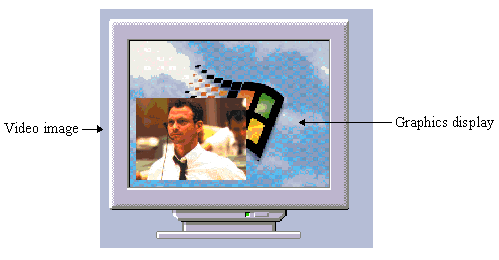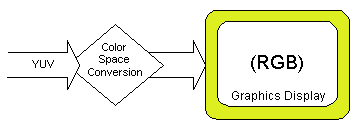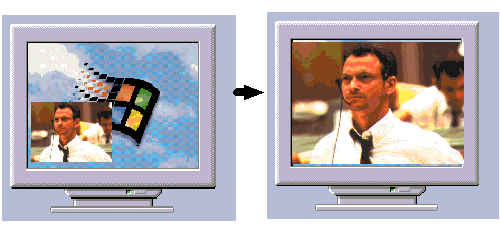SECTION 2. FEATURES
2.1 - General Features
- Accelerates the most frequently used GUI/video operations
- Supports a 64-Bit display memory data bus
- Supports up to 2MB of Extended Data Output (EDO) DRAM
- Supports a wide variety of resolutions, color depths, and refresh rate
2.2 - Advanced Features
- Hardware video accelerator function
- Direct3D graphics acceleration
- Can output to either a VGA monitor or an NTSC/PAL TV
- Video overlay
- Vertical & horizontal scaling (interpolation)
- MPEG support
2.3 - Compatibility
- 486SX/DX/DX2/DX4 and Pentium PCI Systems
- 100% IBM VGA on BIOS, register and hardware levels
- Non-interlaced and/or interlaced monitor support
- Compatible with multi-scanning and PS/2 ( monitors
- Compatible with PAL & NTSC TV's, connecting with a standard Composite Video jack or S-Video jack
- Supports VESA Display Power Management Signalling (DPMS) which decreases energy consumption when used with a compatible monitor
- Supports the standard IBM Feature Connector (FC) for sending graphics data to an add-on video controller or for receiving video from the video controller for video overlay
- Can auto configure by communicating with VESA DDC2B monitors
- Contains drivers for the most popular operating systems and software available today
2.4 - Resolution and Color Selection
- Supports 640x480 in 16, 256, 64k and 16M colors non-interlaced
- Supports 800x600 in 16, 256, 64k and 16M colors non-interlaced
- Supports 1024x768 in 16 & 256k colors non-interlaced
2.5 - Extended Text Display
- 80 column text modes in 30, 43 and 60 rows
- 132 column text modes in 25, 30, 43 and 60 rows
2.6 - GUI Accelerator
Accelerates the most frequently used functions in today's graphics intensive environments, in ;
- BitBLT
- Image and Text Transfer
- Area Fill
- Line Draw
- Short Stroke Vector Draw
- Hardware Cursor
2.7 - Direct 3D
Direct 3DTM was developed by Microsoft( and is the true standard by which 3D graphics software and hardware is based. Many of today's games, educational, business and internet applications are using Direct3DTM in their programming in order to bring amazing 3D graphics in to the home and office. The ProVidia9685TM is fully compatible with Direct3DTM together with its advanced Video Accelerator Function to un-burden the CPU of performance sapping tasks, allowing applications to run at higher resolutions & frame rates, and with higher 3D imagery, which vastly enhances the effect of 3D graphics.
2.8 - Video Accelerator Function
An essential part of the MegaVision 3D ProVidia9685TM chipset is its hardware acceleration of video functions, the most important of which are ; Video Overlay, Color Space Conversion and Scaling. By implementing these features in hardware the ProVidia9685TM allows smooth, full-color, mixed mode playback of video with less usage of the CPU compared to other video controllers and methods.
Normally to display video in a window, the video information must go through the CPU for decompression, then the CPU must scale the image, do the necessary color conversions and manage putting the information on to the screen by sending the video overlay information to the graphics display. On-screen information (i.e. areas covered by the video overlay) must be stored in a separate memory area, either in off-screen video memory or in main system memory, which causes delays when restoring the original image to the screen. The illustration below graphically depicts the amount of work that must be done by the CPU.
| CPU Tasks | Normal Graphic Adapter |
|---|
| Video Data Transfer | Decompression | Scaling | Color Space conversion | Overlay | Graphics display |
In contrast the ProVidia9685TM video overlay functions, when called by the proper driver such as Trident's DCI driver in Windows 3.1, allow the video image to be mixed with on-screen graphics data without trading the graphics data out of its original area in display memory. These functions also perform color conversion and scaling without the intervention of the CPU, as depicted below. This results in smoother video playback and it frees the CPU for other tasks.
| CPU Tasks | MegaVision 3D
Graphic Adapter |
|---|
| Video Data Transfer | Decompression | Scaling | Color Space conversion | Overlay | Graphics display |
| | | | | |
2.9 - Video Overlay
The MegaVision 3D overlay function allows a video image to be placed on screen simultaneously with graphics data without removing the graphics data from the memory. This results in seamless transitions from graphics to video so that when the video functions obscure graphics data, the graphics data is still in its original location and restoring the graphics data becomes instantaneous.

2.10 - Color Space Conversion
Color Space Conversion means that the YUV input to the ProVidia9685TM is automatically converted to true color for display in the video window without the intervention of the CPU.

2.11 - Vertical & Horizontal Scaling
Scaling is essentially the process of taking video data and fitting it to the desired on-screen area. This allows relatively compact data, which is easily transported and stored, to be displayed full-screen. Vertical & horizontal interpolation with Trident's proprietary edge-recovery technique provides higher picture quality. By doing scaling independently of the CPU, the larger picture comes free of any penalties on applications performance. The MegaVision 3D offers any size of vertical and horizontal scaling from iniature live display icons to full-screen display. The ProVidia9685TM scaling algorithm minimizes the loss of image quality in full-screen zoon out.

2.12 - TV-Out
The MegaVision 3D is capable of displaying all standard and some extended VGA video modes on a PAL or NTSC TV. Resolutions up to 640x480 can be displayed on an NTSC TV's, while resolutions up to 800x600 can be displayed on PAL TV's. Extra features are built-in to reduce line flickering and to vertically scale the image for TV display.
The image can be displayed on a TV display in either OverScan mode, as in normal TV displays where the image fills the entire screen, or in UnderScan mode as is done in normal VGA monitors where the image edges are visible with a dark space between them and the monitor's edges.